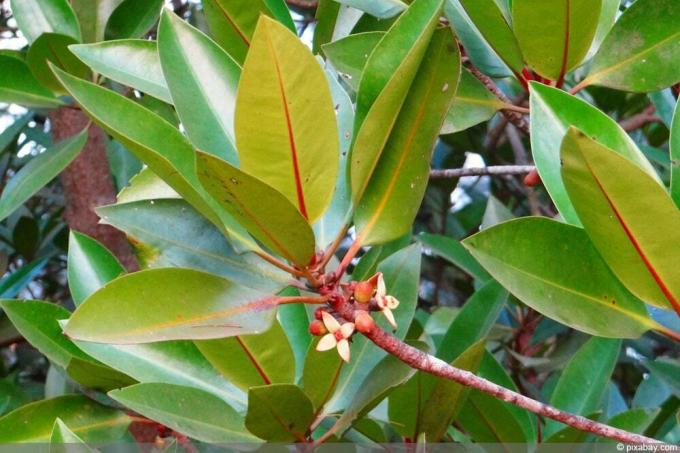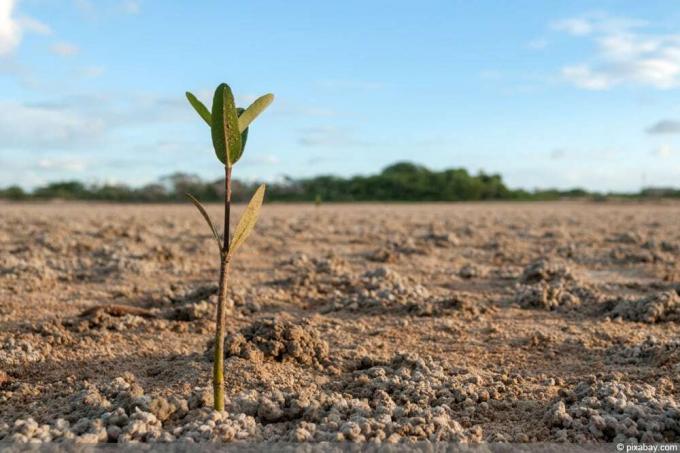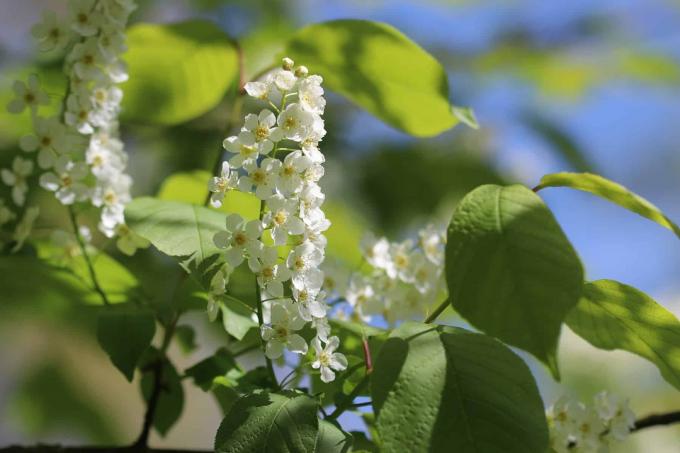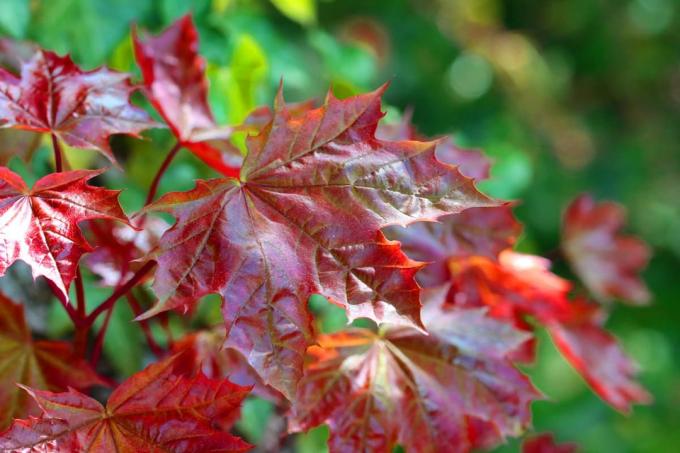

Table of contents
- What are mangroves?
- Adaptation to an extreme habitat
- root
- reproduction
- occurrence and distribution
- Ecology and economic importance
- Destruction of mangrove forests
- The most common mangrove species
- The mangrove as a houseplant
- requirements
- Cultivating mangroves in pots
- Mangrove culture in the aquarium or terrarium
Mangrove trees thrive best where living conditions are deadly for common tree species: beneath scorching sun, with its roots in the oxygen-poor and unstable mud and often submerged in the salty one seawater. They are exposed to the constant changing of the tides and provide valuable habitats for hundreds of species of land and sea creatures. Mangrove forests line the coasts of tropical regions and keep off devastating floods.
What are mangroves?
"The" mangrove tree does not exist, because under the term "mangroves" tropical coastal forests consisting of different tree and shrub species are summarized. There are around 70 different, evergreen species of mangrove trees worldwide, many of which do not even belong to the same plant family. But they have one thing in common: They thrive under extreme living conditions that are deadly for most other trees:
- high salt concentrations
- muddy, flooded and unstable ground
- in the sphere of influence of strong tidal currents
The shrubs and trees have adapted perfectly to these changing conditions by developing special physiological processes and structures.
Nonetheless, it is a delicate ecosystem whose development and continued existence is severely endangered by human intervention.
Adaptation to an extreme habitat
Without their characteristic survival strategies, mangroves would have no chance in their traditional habitat. For example, the different species have developed strategies to compensate for the high salt concentrations. Basically, the trees can be divided into two groups: The first developed glands that allow the salt absorbed with the roots to be excreted through the leaves. The second group, on the other hand, stores the salt in the succulent leaves, dilutes the concentration through increased water uptake, and eventually sheds the foliage.
root

The roots of conventional trees need permeable soil that supplies the subterranean system with sufficient oxygen. Mangrove roots, on the other hand, cannot “breathe” because the subsoil contains little or no oxygen. Regular flooding with sea or brackish water (which is a mixture of salt and fresh water) does the rest in this respect. However, special respiratory roots enable the tree roots to absorb oxygen, as water-impermeable lenticels, the finest root pores, filter out oxygen during an ebb. This is consumed in the subsequent flooding, during which the plant cannot actively breathe.
reproduction
The third problem is the unstable ground, which actually makes it impossible to anchor firmly. In addition, the constant tidal movements threaten to wash away the trees as well. Special stilt roots support the tree roots and thus ensure that they can withstand the constant mechanical loads. Many mangrove species ensure their reproduction under these conditions by germinating their seeds on the mother tree leave - and the buoyant seedling can float on the water until it finds a suitable location for rooting finds. In this case, the formation of roots and leaves occurs extremely quickly.
occurrence and distribution
Mangroves thrive in warm and rainy tropical coastal regions and are primarily found along the Central and South American, African, Indian and Southeast Asian seacoasts find. Since they are dependent on calm water within the tidal currents, they form primarily in the Estuaries of large rivers, in the sea behind coral reefs and in bays are the typical ones mangrove forests.
The trees only thrive in tropical regions with water temperatures of more than 20 degrees Celsius all year round, and the climate should remain the same all year round. The warmth of the air, on the other hand, is not decisive for the spread and settlement of mangroves.
Ecology and economic importance
Mangrove forests form a unique, very sensitive ecosystem that offers a protected habitat for both land and sea animals. Hundreds of species of fish, reptiles, amphibians, molluscs and crustaceans have their breeding grounds here, which also includes the Taking advantage of coastal dwellers: The people who traditionally live from fishing prefer to go fishing in the mangrove forests Hunt. The upper floors of the trees, on the other hand, are reserved for typical land dwellers such as birds and reptiles such as snakes. If the mangroves are cut down, the species adapted to this ecosystem lose their habitat and also disappear.

Furthermore, the sometimes huge mangroves protect the coastal regions, stabilize the soil and prevent soil erosion. In addition, the forests stop severe flooding in the coastal area, especially during the rainy season. The population also uses the mangrove wood as fuel and for building houses. Last but not least, plants with edible fruits and valuable medicinal plants thrive here.
Destruction of mangrove forests
Mangrove forests have been cut down extensively for several decades - for example in order to be able to build coveted properties directly on the beach plots. Furthermore, there is use for the breeding of shrimps or shrimps, as a result of which the mangroves abused for this purpose die off due to contamination by chemicals and medicines. The land is then contaminated for decades and cannot be reforested.
In some countries - such as Thailand - about a fifth of the mangrove destruction is due to industrial shrimp farming. The effects are clearly visible: Not only are the yields from inshore fishing strong receding, storm surges and other floods are hitting the coasts unchecked, causing thousands Dead. In the meantime, some countries such as Vietnam, Thailand or Malaysia are trying to counteract this and are increasingly promoting reforestation projects.
The most common mangrove species
Mangrove trees do not form their own genus, but belong to various plant families assigned to the angiosperm plants (Magnoliophyta).
Red mangrove (Rhizophora mangle)
This mangrove tree is probably the best known. It is commonly found along the American coast between Florida and Brazil and in West Africa. This very dominant species even drives out other mangroves, is extremely robust and adaptable.
Tip:
Anyone who uses mangroves as a houseplant or If you want to cultivate in an aquarium, you should try this comparatively easy-to-cultivate species. Under the right conditions, Rhizophora mangle also shows dwarfism, so it remains attractively small.
Black mangrove (Avicennia germinans)
This mangrove species, which belongs to the acanthus family (Acanthaceae), often forms large forests along the American and West African coasts together with the red and white mangroves.
Oriental mangrove (Bruguiera gymnorhiza)
Sometimes incorrectly referred to as the "Caribbean mangrove," this species is found exclusively in West Africa, Asia, and Australia and Oceania. It owes its name to its original range in the Middle East, where it has been extinct for several decades.

Stilted Mangrove (Rhizophora stylosa)
Closely related to the red mangrove, this species occurs primarily along the Indian and Pacific coasts from India to Samoa. Rhizophora stylosa owes its name to the pronounced stilt roots, which are said to provide stability in the muddy ground.
White mangrove (Laguncularia racemosa)
The white mangrove is the only mangrove species that belongs to the Combretaceae plant family. It is native to the American and West African coasts.
Gray mangrove (Avicennia marina)
Also sometimes referred to as the "White Mangrove", this mangrove is native to the east coast of Africa and along the seacoasts of Asia and Australia. It has the largest distribution area of all mangrove species.
nipa palm (Nypa fruticans)
Mangroves not only develop tree or shrub-like growth forms, there are also palm trees among them. Although these have a woody trunk, they still do not count as trees. Instead, they form a group of their own because, unlike "real" trees, their trunk does not grow thicker. The nipa palm with its characteristic large leaves is found exclusively in Southeast Asia.
The mangrove as a houseplant
Under certain conditions, some mangrove species can be cultivated as a pot plant or as part of a freshwater or saltwater aquarium. In their natural habitat, many mangrove trees reach a height of between 25 and 30 meters and an age of up to 100 years. However, under unfavorable growth conditions and in "captivity", most trees remain dwarfed. In addition, any strong growth can be well controlled by regular pruning, so that the plant does not grow too large and exceed its growth frame.
requirements

So that the mangrove tree does not die within a very short time, the following conditions should be met:
- Air temperature all year round between 25 and 30 °C
- Water temperature at least 20 °C all year round
- some species require between 24 and 26 °C
- Ground temperature between 23 and 25 °C all year round
- Humidity between 60 and 80 °C
- 10 to 12 hours of lighting daily
- artificial lighting is absolutely necessary
- use special mangrove soil and fertilizer!
This information applies to all mangroves that can be cultivated in pots or aquariums.
Cultivating mangroves in pots
In view of the necessary conditions, only a few enthusiasts should be able to cultivate their mangrove on the windowsill. In particular, the humidity and temperature are likely to be difficult to maintain all year round.
Mangrove culture in the aquarium or terrarium
Therefore, a culture in the more controllable freshwater or saltwater aquarium or tropical terrarium. No organic, but inorganic material such as sand or gravel should be used as a substrate. Mangroves that are cared for in this way also thrive very well in hydroponics.
 garden editorial
garden editorial I write about everything that interests me in my garden.
Learn more about Baumlexikon

Bird cherry, Prunus padus: caring for, pruning & propagating
The bird cherry is a shrub or tree that is the ideal bee pasture in a natural garden. However, the plant should also be viewed with caution, as it is a poisonous plant for horses. Nevertheless, it is popular in the local colorful hedges.

Red maple: 9 tips for caring for, cutting & overwintering
The red maple is one of the most impressive trees in Germany due to its unusual scarlet leaf colour. Here you can find out how to integrate this impressive plant into your garden and how to keep it healthy and vigorous.

Sycamore tree: Properly care for and cut sycamore trees
The plane tree (Platanus) has a high decorative value. In terms of care, it is mostly undemanding, which is why it is often chosen as a street tree. Nevertheless, there are a few details to be observed when it comes to care, as described in the home garden guide.

Birch locations: 5 important criteria
Birch trees are extremely frugal trees and are particularly eye-catching and decorative thanks to their light-colored bark. When choosing a location, however, a few factors should be considered in order to create optimal conditions for their growth and to protect the environment.

Cutting dwarf pine - instructions for the perfect cut
Dwarf pines can be pruned by thinning out, topiary or limbing. A bonsai design with needle and root pruning is also possible. So that the wood does not look unattractive after the pruning measure, a few rules of technology should be observed.

Is the vinegar tree poisonous? | Who is it dangerous for?
In ornamental gardens, the vinegar tree is an attractive eye-catcher due to its unusual flowers and the appealing autumn color of its feathered leaves. The red, upright fruit cobs (flowers) are responsible for the striking appearance. Despite everything, the vinegar tree is not an unproblematic tree.

